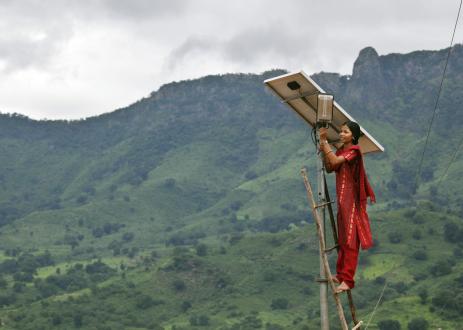The Future Electricity Grid
发展中国家的关键问题和考虑因素

Synopsis
可再生能源(RE)在全球范围内正在增长,在过去的十年中,非Hydro可再生能源从85吉瓦(GW)增长了六倍。该报告回顾了解释RE增长的主要趋势,并强调了它们在巴西,中国,印度和吉尔吉斯斯坦等国家的挑战性决策。
单击图形进行放大。
关键发现
可再生能源的增长可以归因于5个关键市场趋势:
- 可再生能源的前所未有的增长和成本提高
- 改进新技术和能源效率
- 化石燃料供应和价格的不稳定
- Growing support from governments and investors
- 新实体和不同实体的发电
这些趋势正在造成电力部门的不确定性,并引起新的挑战,迫使决策者思考如何最好地做出反应。监管机构,网格操作员,规划人员和公用事业现在必须与以下的技术变化抗衡,同时还可以平衡常规的,预先存在的压力,以增加电力通行,增加提供的电力的数量和可靠性,并提高所提供的电力和可靠性提供的服务质量。通常,该报告发现,决策者需要应对三个关键挑战,以建立一个未来的网格,以提供清洁,可靠和负担得起的能源:
- Technology and Infrastructure:由于采用了新的间歇技术和分布式生成,因此对网格的复杂性和物理限制增加了。传统的电网正在发展成为一个更复杂的网络,该网络在设计,操作和管理方面变得越来越具有挑战性。
- Institutional Arrangements:The conventional, central utility model is being challenged by quickening trends toward distributed, on-site, and self-generation. The centralized, top-down approach to operating the grid is being tested and the role of the conventional utility is being brought into question.
- 电力定价和公平性:由于新一代和网格技术的规模扩大以及向新一代模型转移的规模,引起了电力定价和公平问题,这引起了有关适当和公平的关税,跨补贴和成本负担的问题。
执行摘要
Changes in the sector, driven in part by objectives such as energy security, socio-economic development, increasing sustainable energy, environmental protection, climate change mitigation, public health, and increased public choice, are causing a number of trends: new and disruptive technologies, including variable renewable energy, small distributed generation and storage, are being deployed; new players such as individual homeowners and communities, are arising as legitimate electricity generators; and overall market dynamics are changing with the introduction of policy support mechanisms for clean energy, and increased competition. With these changes a new set of questions are arising regarding technical, institutional, and economic restructuring necessary to integrate these changes, and turn potential system wide threats into opportunities.
这些变化不仅在发达国家,而且在印度等发展中国家发生。本报告回顾了这些趋势如何挑战当前的比赛状态,以及在巴西,中国,印度和吉尔吉斯斯坦的系统规划人员,电力公司,监管机构,消费者和政策制定者如何积极地开始计划过渡到未来网格。
项目
-

清洁能源
Visit ProjectWorking with electricity customers, cities, regulators and utilities to drive the transition to a low-carbon grid.
部分 Energy -




